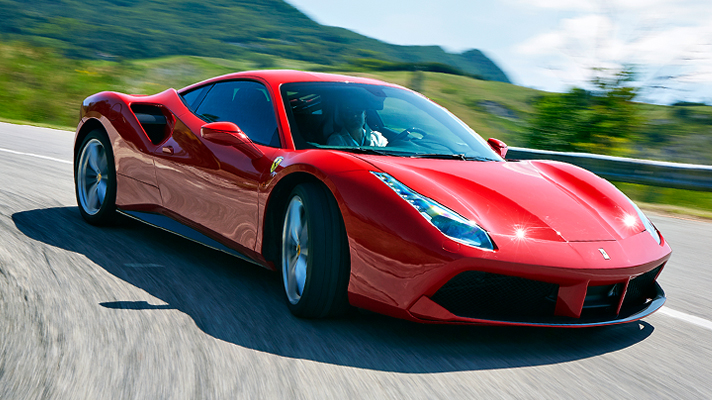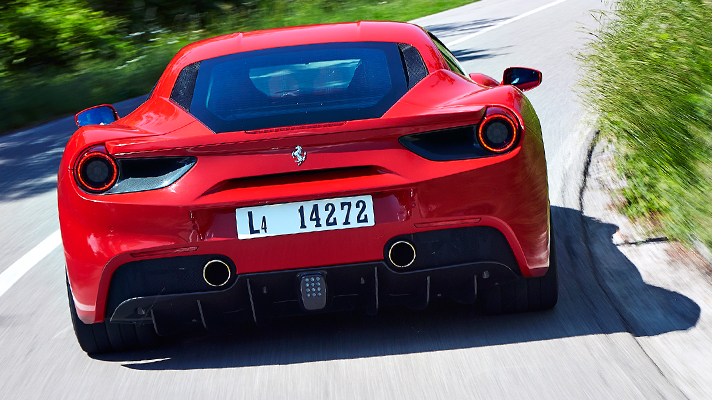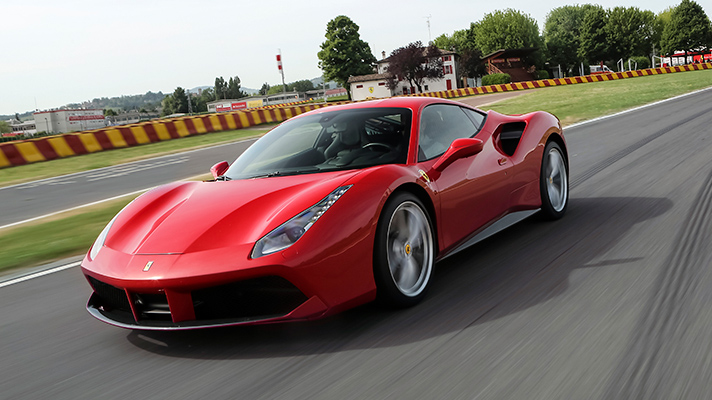
SPEC HIGHLIGHTS
- BHP
661bhp
- 0-62
3s
- CO2
260g/km
- Max Speed
205Mph
What's this, then?
At the risk of sounding like the dramatic voiceover from an action movie trailer, this is a big moment in the history of fast cars.
The Ferrari 488 GTB is the replacement for the 458 Italia and potentially a very large nail in the coffin of natural aspiration.
Yes, the atmospheric V8 Ferrari is dead: Ferrari's mid-engined supercar has gone turbocharged.
Why?
Two reasons: power and economy. Though Maranello is officially exempt from average CO2 targets binding mass-market manufacturers, it must be seen to show willing - and short of bolting on a heavy, expensive hybrid module (or switching to diesel), turbocharging is the only realistic way to raise efficiency and lower emissions.
Perhaps more significantly, though, it's about keeping up in the power wars. With Ferrari targeting an increase of around 100bhp on the 458 Italia, Maranello's engineers admit it would have been all but impossible to squeeze so much more from the naturally aspirated V8, at least not without compromising reliability, thoroughly blowing the budget or embracing a much bigger, heavier engine.
Look at the bald figures, and it's difficult to argue. 2004's Ferrari F430 made 483bhp and 343lb ft from its 4.3-litre, naturally aspirated V8 engine. It'd do 0-62mph in 3.7 seconds and 0-124mph in 12.2, while officially returning 18mpg and 345g/km CO2.
The new 488 GTB? 661bhp - a near-180bhp jump in 11 years - and 560lb ft from its twin-turbo 3.9-litre V8. Vital stats? 3.0 seconds to 62mph and 8.3 to 124mph, along with 25mpg and a piffling 260g/km CO2. That, in strictly numerical terms, is serious progress.
That 661bhp headline equates to the highest specific power output of any road-going Ferrari, a meaty 169bhp per litre of displacement. If the Dodge Viper's V10 managed the same power density, it'd make 1400bhp.
Top Gear
Newsletter
Thank you for subscribing to our newsletter. Look out for your regular round-up of news, reviews and offers in your inbox.
Get all the latest news, reviews and exclusives, direct to your inbox.
But supercars aren't just about numbers. They're about, like, sensation and stuff.
Correct. Those who buy city cars, or motorway rep-mobiles, will accept fuzzy throttle response and a droney noise as a trade-off for a decent squirt of overtaking power and a half-price tax disc.
Not those in market for a screaming V8 supercar, as Ferrari is well aware. One of the trademarks of the 458's naturally aspirated eight was its whipcrack reactions up and down the rev range, spinning up and back with extraordinary, inertia-free alacrity. Maranello knows it needs to serve up a similarly engaging experience with its mid-engined turbo offering, so has thrown its full suite of engine tech at the 488's powerplant.
It's a new flat-plane crank V8 of no relation to the 458's, dry-sumped and, Ferrari claims, offering the quickest throttle response time of any blown sports car engine. If you're doing 2000rpm in third gear and stab the throttle, the 488 will give you maximum power in point-eight of a second. That, says Ferrari, is just a tenth shy of the 458's reactions, an engine never regarded as tardy, exactly.
Hang on. Isn't it the same engine as the California T?
The 3902cc V8 engine is from the same ‘F154' family as that of the new California T, but shares very little in the way of individual components with the Cali's wet-sumped motor.
There's a new crank and conrods; redesigned cylinder heads; new cams, intake system and cranktrain; bespoke intercoolers. A different, noisier exhaust too.
Even the turbos are all-new, the compressor wheels fashioned of an aerospace-grade, low-density titanium-aluminium alloy to reduce inertia, with Ferrari boldly promising ‘zero lag'.
Does it deliver?
We'll come to that in a sec. First you need to know about the aero.
If Ferrari let its engineers go crazy on the engine, the aerodynamics clearly represent a breakout at the asylum. There's plenty of F1-derived knowhow here - in fact, so strict are Formula One's bodywork regulations that there's arguably more aero cleverness here than on Seb Vettel's F2015. Only the roof panel has been carried over from the 458.
Up front is a double spoiler, the top section ramming air into the radiator while the larger, lower section generates downforce under the front of the car.
The underbody includes faintly ominous sounding vortex generators, which reduce pressure to create ground effect without adding drag. The result, says Ferrari, is a car with a lower drag coefficient than its predecessor, but one capable of generating 325kg of downwards lift a 155mph. That's proper downforce, 50 per cent more than the 458 generates.
Need more aero? Round the back there's a diffuser with computer-controlled active flaps, which open or close to reduce drag or increase downforce respectively.
And see that little hole at the base of the rear screen? That's the intake for the 488's 'blown spoiler' arrangement.
"We don't like to add aerodynamic devices on top of the form," explains Ferrari design chief Flavio Manzoni. So instead of a fat, 911 GT3 RS-style rear wing, the 488 instead rams air through this dinky intake where it passes over a hidden lip, pushing the 488's rear to the road. Subtle and very clever.
Got it. There's a lot of aero going on. Anything else?
The rest of the hardware should be familiar from the 458, though upgraded across the board.
The 488 retains Ferrari's trademark aluminium-intensive body structure - no McLaren 650S-style carbon-fibre monocoque here - and employs a seven-speed dual-clutch transmission, which limits torque in lower gears to maximise acceleration without simply spinning the rear wheels. Software tweaks allow for upshifts up to 30 per cent quicker, and downshifts up to 40 per cent quicker.
The now-familiar magnetorheological active dampers get a faster ECU, three new sensors and new piston rods promising better body control.
Under 20-inch alloys wrapped in bespoke Michelins lurk Brembo brakes from the LaFerrari, with stopping distances reduced some nine per cent over the 458.
Oh, and, there's an evolved version of 458's genius Side Slip Control (unofficial motto: Helping The Ham-Fisted Drift since 2009!), which promises to be 'more precise and yet less invasive'.
Out with it. What's it like to drive?
Fast. Very fast. Very, very fast.
The 488's acceleration is a step up from the 458 and even the Lambo Huracán, flinging you down the road with the shocking, brutal thrust of a fighter jet on take-off.
It's the sort of acceleration that pins you back into the seat, the sort of acceleration that causes a string of involuntary expletives to spew forth from your lips.
The sort of acceleration that, if you break attention for but a split-second, sees you arriving at a tight corner at least 40mph than expected, before hastily testing the capabilities of those Brembos.
Put it this way: if someone has an off in a 488, it's not going to be small. 0-62mph in three seconds dead? More than believable, that.
The surge of torque is utterly relentless, the power arriving in a continuous, unending deluge with barely a bhip between gears. So relentless is the power that I kept battering into the limiter just north of 8000rpm, expecting the rush never to run out.
The brutality of the acceleration reminds me of the Nismo GT-R, but with nothing like the turbo lag. The throttle response is all but instantaneous, the power linear and even and massive.
But does it feel like a proper Ferrari V8?
It doesn't feel like an old Ferrari V8, that's for sure. The turbo engine certainly doesn't gain and lose revs with the massless snap of the old naturally aspirated V8, which would drop from 8,000rpm to idle so quickly you wondered how the rev-counter needle could keep up. The new V8 is just a mite slower in its reactions.
That said, it's a nimble thing by the standards of turbo engines, and, in its own way, a mighty serious piece of industrial engineering. It's a different sort of power, this, broad-shouldered and all-consuming, an unstoppable wrecking-ball of speed.
Does it sound as good as the 458?
It sounds very, very different. Whereas, in the 458 Speciale, you felt you were stretching some sort of mad elastic band as the revs increased, the noise getting higher, tighter, more frenzied, the 488 sounds more linear, controlled, industrial.
Despite Ferrari's claims to have engineered a cacophony of different sounds through the 488's rev range (naturally, mind you - no speaker-based synthesising here), it doesn't have the baritone-to-soprano range of the old naturally aspirated V8, trading the 458's vocal range for a heftier, chest-filling boom. Certainly, it doesn't get all screaming and sparkly at the top end, just louder and angrier.
In fact, the 488 sounds, in part at least, like a modern F1 car with its pit-lane limiter on: a bass-heavy, air-bullying thump overlaid with a medley of whooshes, cracks and mechanical edge. Certainly there's far more to it than mere induction noise, and it's probably the best-sounding turbocharged production motor out there right now, but for me it doesn't have quite the fizz of that atmospheric V8.
It is, however, plenty loud and shouty enough to attract the attention of everyone outside your Monaco apartment, which is probably the major concern of most 488 buyers.
How does it handle?
Drive it sensibly, and the experience is very much like the 458. The steering is light yet direct, the sensation of a balanced and agile chassis, the 488 signalling clearly what its front and rear are up to.
Drive it hard, though, and you discover the 488 is seriously, seriously oversteery.
I'm not the sort of driver to jump in a 600bhp-plus, rear-drive supercar and start immediately drifting it on public roads (I know, what a square), but - with the manettino dialed back to ‘CT OFF' - even I was quickly achieving neat, controllable slides out of corners, hanging the tail out before flicking it back into line.
Partly that's thanks to the vast plateau of torque served up from the V8, which allows you to meter a dead-even, precise amount of power to the rear wheels.
But more - significantly more, if we're being honest - it's thanks to the utter genius of that second-gen Side Slip Control (SSC), which now monitors and adjusts the damping front and rear for even greater slip angles.
This is no now-stop-that-right-now safety net, shutting down the power as soon as it spots a hint of slip. Quite the opposite: it all but encourages you to engage in gorgeous, steady slides, allowing you to get sideways and somehow, imperceptibly, holding you there.
In the pre-match tech briefing, a Ferrari engineer showed us the equation used to calibrate SSC2. It covered an entire page of A4, and looked like something out of The Theory Of Everything. Point is, there's some very clever stuff going on, but as the driver you have no sensation of the electronics doing their thing, just that you've been transformed, overnight, into a Driving God.
And when you're not being a hammer-footed fool?
The 488 isn't an intimidating or difficult car to drive. It's happy to burble through traffic, throttle and brakes forgiving, all-round visibility better than in, say, the Lambo Huracán.
We tried it on some pretty harrowed Italian tarmac, and - with the dampers set to ‘bumpy road' mode at least - it retained a pretty impressive degree of comfort.
Ferrari says a lot of V8 owners use their car as a daily driver, so has worked hard to engineer a bit more space for human and stuff on board. Accordingly, the front boot is of a decent size, while there's room in the cockpit for, ooh, at least a dozen pencils.
But is it better than a 458?
Hmm. Ah. I've spent a long time thinking about this, and I reckon it comes down to a trade-off. Namely this: do you want more power, more speed and even better sideways? Or would you trade that in for the screaming, high-rev thrills of the old atmospheric V8?
This isn't a cop-out, but I think you could argue it either way. The 488 doesn't have quite the tingling effervescence of the 458, doesn't goad you to the redline in quite the same way, doesn't sing so lustily when you get there.
But the 488 feels new, and different, and stonkingly fast. It sounds unique, and offers up a dizzying, crushing surge of torque. It'll get round any track or down any road noticeably quicker than the 458 - the 488 is two seconds a lap faster around Ferrari's dinky Fiorano circuit - and probably use a bit less fuel doing so. Where do your priorities lie?
And let's be honest: the question of whether the 488 is better than its naturally aspirated predecessor is ultimately moot. Yes, turbocharged sports cars are different, but they are happening, and Ferrari's proven they won't all be characterless vacuum cleaners.
The era of natural aspiration is, like it or not, reaching its end. The 488 represents the very forefront of the turbo charge.
Featured







